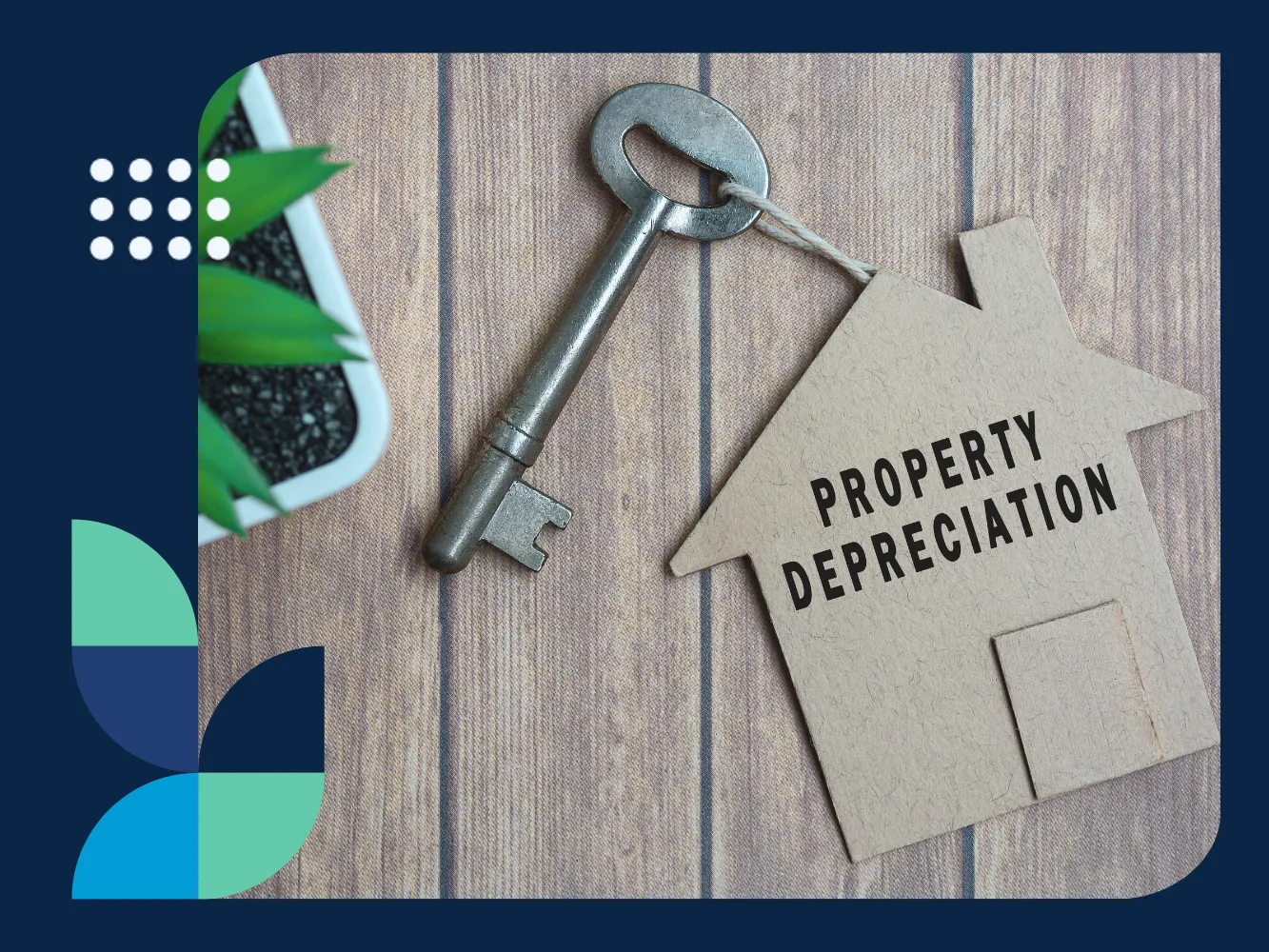Depreciation is one of the most valuable tax benefits available to rental property owners, yet many landlords overlook the financial advantages of rental property appliance depreciation. Whether replacing an old refrigerator or installing a new HVAC system, understanding how to deduct these expenses properly can lower your taxable income and improve your investment returns.
This guide explains how appliance depreciation works, how to calculate it, and how to report it on your tax return. If you’re a landlord looking to maximize your tax savings while staying compliant with IRS rules, this article will give you a step-by-step approach to ensure you’re making the most of this deduction.
Read our in-depth article if you want a complete guide on rental income taxes in general.
Understanding Depreciation in Rental Properties
What Is Depreciation?
Depreciation is the process of deducting the cost of an asset over its useful life rather than expensing it all at once. This applies to rental properties and various assets in real estate, such as buildings, rental property appliance depreciation, and improvements. The IRS recognizes that assets lose value over time due to wear and tear, so depreciation allows property owners to account for this loss in value while reducing taxable income.
For example, if you purchase a refrigerator for your rental property, you can’t deduct the full cost in the year you buy it. Instead, you must spread that deduction over the asset’s IRS-defined lifespan, which could be five years for appliances or 27.5 years for the rental property itself.
How Depreciation Affects Taxable Income
Depreciation is one of the most significant tax benefits for rental property owners. It allows you to deduct a portion of your property’s cost each year, lowering your taxable income even if it generates rental income.
Here’s a simple example:
- Suppose you own a rental property valued at $275,000 (excluding land, which is not depreciable).
- Under IRS rules, residential rental properties are depreciated over 27.5 years.
- Each year, you can deduct approximately $10,000 ($275,000 ÷ 27.5) from your taxable income.
This deduction effectively reduces the rental income subject to tax, increasing your profitability. Even though you’re not spending that $10,000 out of pocket, it still helps lower your tax liability.
IRS Guidelines on Depreciation
The IRS has specific rules on what can and cannot be depreciated and how depreciation should be calculated. Some key guidelines include:
- Depreciable Assets: You can only depreciate assets that have a useful life of more than one year and are used for business purposes. This includes buildings, appliances, furniture, and property improvements. Land itself is not depreciable.
- MACRS System: The IRS requires rental property owners to use the Modified Accelerated Cost Recovery System (MACRS), which determines the depreciation schedule based on asset type.
- Residential rental properties are depreciated over 27.5 years.
- Commercial properties are depreciated over 39 years.
- Personal property such as appliances, carpets, and furniture is usually depreciated over 5 to 7 years.
- Start Date for Depreciation: Depreciation begins when the property is placed in service (available for rent), not when it is purchased.
- Recapture Tax: If you sell a rental property, the IRS may require you to pay back some of the tax savings from depreciation through depreciation recapture, which is taxed at a higher rate than long-term capital gains.
Special Depreciation Rules and Deductions
Some additional depreciation-related deductions can benefit rental property owners:
- Bonus Depreciation: This allows landlords to deduct a significant portion (or even 100%) of qualifying asset costs in the year of purchase rather than spreading them out. However, bonus depreciation rules change periodically based on tax laws.
- Section 179 Deduction: Unlike standard depreciation, Section 179 allows businesses (including landlords, in some cases) to deduct the full cost of eligible assets in the year they are placed in service rather than following MACRS. However, residential rental property improvements generally do not qualify.
- Repairs vs. Depreciation: Routine repairs (such as fixing a broken window) are deductible as expenses in the year they occur. In contrast, improvements (such as installing a new roof) must be depreciated over time.
What Qualifies as an Appliance for Depreciation?
For an appliance to qualify for depreciation, it must meet specific IRS criteria:
- Used for business purposes: The appliance must be installed in a rental property to generate rental income. Personal-use appliances in your primary residence are not eligible.
- Have a useful life of more than one year: Short-term or disposable items do not qualify. The IRS assigns specific recovery periods for depreciable assets, ensuring deductions are spread over time.
- Not classified as a repair or routine maintenance: Repairs are considered immediate expenses and are fully deductible in the year they occur. In contrast, appliances that improve or extend the useful life of the rental property must be depreciated over time.
Common Depreciable Appliances
The IRS allows landlords to depreciate most major appliances in rental properties. These typically include:
- Refrigerators – Essential for residents, typically depreciated over 5 years.
- Ovens and stoves – Both gas and electric models are depreciable over 5 years.
- Dishwashers – Considered part of kitchen upgrades, depreciated over 5 years.
- Washing machines and dryers – Useful for rental properties with laundry facilities, depreciated over 5 years.
- HVAC systems (including air conditioners) – Larger units may fall under building systems rather than appliances, potentially requiring a 27.5-year depreciation schedule.
- Water heaters – Essential for resident use, typically depreciated over 5 years.
Repairs vs. Capital Improvements
Not all appliance-related expenses qualify for depreciation. The IRS differentiates between repairs, which can be fully deducted in the year they occur, and capital improvements, which must be depreciated.
- Repairs: Routine maintenance or minor fixes that restore an appliance to working order without significantly extending its life. These costs are fully deductible in the tax year they occur.
- Example: Fixing a broken washing machine belt → Deducted immediately.
- Example: Replacing a faulty oven heating element → Deducted immediately.
- Capital Improvements: When an expense extends the appliance’s useful life or enhances its performance, it is considered an improvement and must be depreciated.
- Example: Replacing an old dishwasher with a new one → Depreciated over 5 years.
- Example: Upgrading from a basic HVAC system to a high-efficiency model → Depreciated over 5 or 27.5 years, depending on classification.
Understanding these distinctions helps landlords optimize tax deductions while complying with IRS regulations. If unsure whether an expense qualifies as a repair or improvement, consulting a tax professional can ensure correct classification and maximize allowable deductions.
Depreciation Methods for Appliances
The Modified Accelerated Cost Recovery System (MACRS)
The IRS requires landlords to use the Modified Accelerated Cost Recovery System (MACRS) to depreciate rental property assets, including appliances. MACRS determines how quickly an asset can be written off for tax purposes and consists of two main systems:
- General Depreciation System (GDS) – The most commonly used method, allowing landlords to depreciate appliances over 5 or 7 years.
- Alternative Depreciation System (ADS) – Used in specific circumstances, such as foreign-owned properties or tax-exempt entities, requiring appliances to be depreciated over 9 or 12 years instead.
GDS is the standard depreciation method for rental property owners since it allows for faster tax deductions. While ADS is only necessary in certain cases, such as when IRS regulations mandate its use.
Recovery Periods for Appliances
The depreciation period for appliances depends on the system used:
- General Depreciation System (GDS) – Most residential rental appliances, such as refrigerators, ovens, dishwashers, and washing machines have a 5-year recovery period.
- Alternative Depreciation System (ADS) – If ADS is required, the same appliances must be depreciated over 9 years instead.
The choice between GDS and ADS depends on eligibility and tax strategy. Since GDS allows landlords to recover costs more quickly, it is generally preferred unless IRS rules dictate the use of ADS.
By understanding these depreciation methods, landlords can maximize their tax benefits while complying with IRS regulations.
Calculating Rental Property Appliance Depreciation Step-by-Step
Depreciating an appliance involves determining its cost basis, selecting the appropriate depreciation method, and applying IRS-prescribed percentages over the asset’s useful life. Below is a clearer breakdown with tables for easy understanding.
Step 1: Determine the Depreciable Basis
The depreciable basis includes all costs directly related to the purchase and installation of the appliance.
| Expense Category | Amount |
|---|---|
| Purchase Price of Appliance | $1,500 |
| Sales Tax | $50 |
| Shipping Costs | $100 |
| Installation Fees | $200 |
| Total Depreciable Basis | $1,850 |
If an expense is required to bring the appliance into service, it is included in the depreciable basis.
Step 2: Choose the Depreciation Method
The IRS requires landlords to use the Modified Accelerated Cost Recovery System (MACRS). Within MACRS, there are two main methods:
| Depreciation Method | Appliance Recovery Period | When It’s Used |
|---|---|---|
| General Depreciation System (GDS) | 5 Years | Most common method for landlords |
| Alternative Depreciation System (ADS) | 9 Years | Used for tax-exempt entities, foreign-owned properties, and certain IRS requirements |
Most landlords will use the GDS method with a 5-year depreciation period.
Step 3: Calculate Depreciation Using MACRS Tables
Under GDS with MACRS, appliances are depreciated using fixed annual IRS percentages. The half-year convention applies, meaning only half a year’s depreciation is allowed in the first year.
Below is the IRS MACRS Depreciation Table for a 5-Year Recovery Period under GDS:
| Year | MACRS Percentage | Calculation (Depreciable Basis × Percentage) | Annual Depreciation Deduction |
|---|---|---|---|
| 1 | 20.00% | $1,850 × 20% | $370 |
| 2 | 32.00% | $1,850 × 32% | $592 |
| 3 | 19.20% | $1,850 × 19.2% | $355.20 |
| 4 | 11.52% | $1,850 × 11.52% | $213.12 |
| 5 | 11.52% | $1,850 × 11.52% | $213.12 |
| 6 | 5.76% | $1,850 × 5.76% | $106.56 |
| Total | 100% | $1,850 |
Each year, you multiply the depreciable basis ($1,850) by the MACRS percentage for that year. This determines how much depreciation you can deduct from taxable income.
Step 4: Account for Partial-Year Depreciation (Half-Year and Mid-Quarter Rules)
The IRS requires landlords to apply either the Half-Year Convention or Mid-Quarter Convention, depending on when the asset is placed into service.
| Scenario | IRS Convention Used | Effect on First-Year Depreciation |
|---|---|---|
| Appliance placed in service in the first half of the year | Half-Year Convention | First-year depreciation is half of the full-year amount. |
| More than 40% of total depreciable assets were placed into service in the last quarter of the year | Mid-Quarter Convention | Depreciation follows IRS mid-quarter rules, adjusting percentages per quarter. |
Example: Half-Year Convention Applied
If an appliance was placed in service in July, depreciation for Year 1 is cut in half (50% of the regular deduction). The remaining depreciation shifts into Year 6.
| Year | MACRS Percentage | Standard Deduction | Adjusted for Half-Year Convention (50%) |
|---|---|---|---|
| 1 | 20.00% | $370 | $185 |
| 2 | 32.00% | $592 | $592 |
| 3 | 19.20% | $355.20 | $355.20 |
| 4 | 11.52% | $213.12 | $213.12 |
| 5 | 11.52% | $213.12 | $213.12 |
| 6 | 5.76% | $106.56 | $159.36 (extra depreciation carries into Year 6) |
If the appliance is placed into service mid-year, first-year depreciation is cut in half, and the remaining balance shifts into Year 6.
| Key Takeaways: |
|---|
To calculate rental property appliance depreciation, follow these steps:
|
Reporting Depreciation on Your Tax Return
Once you’ve calculated depreciation for your rental property appliances, you must report it correctly on your tax return. The IRS provides specific forms and guidelines to ensure compliance.
IRS Forms Required for Reporting Depreciation
| Form | Purpose |
|---|---|
| Form 4562 | Used to report depreciation and amortization for business and rental property assets. This form must be filed in the first year you depreciate an appliance and any year additional assets are placed in service. |
| Schedule E (Form 1040) | Used to report rental income, expenses, and depreciation deductions for each rental property you own. The amount calculated from Form 4562 is entered on this form under “Depreciation Expense.” |
Most landlords will file Form 4562 to report depreciation and transfer the deduction amount to Schedule E when filing their taxes.
Record-Keeping Requirements
To ensure you can substantiate depreciation claims in case of an IRS audit, maintain detailed and organized records of:
| Record Type | Why It’s Important |
|---|---|
| Purchase Receipts | Verifies the cost basis of the appliance. |
| Installation Invoices | Confirms the appliance was placed into service for rental use. |
| IRS Depreciation Schedules | Documents the applied MACRS percentages and recovery periods. |
| Yearly Depreciation Calculations | Ensures accurate reporting on tax returns each year. |
Tip: To comply with IRS documentation requirements, keep all records for at least three years after the property is sold or the appliance is fully depreciated.
Special Considerations for Depreciating Appliances
New vs. Used Appliances
- Both new and used appliances qualify for depreciation, provided they are placed into service in a rental property.
- The same 5-year depreciation schedule under GDS applies regardless of whether the appliance is new or previously owned.
Improvements or Additions to an Appliance
If you upgrade or replace an existing appliance, special rules apply:
| Scenario | How It’s Depreciated |
|---|---|
| Replacing an old appliance | The new appliance is depreciated separately from the old one. |
| Upgrading an existing appliance | If the cost significantly extends the appliance’s useful life, the expense must be capitalized and depreciated. |
| Minor repairs to an appliance | Costs are fully deductible in the year incurred and do not need to be depreciated. |
Upgrades or full replacements must be depreciated, while repairs are deductible immediately.
Selling or Disposing of a Depreciated Appliance
If you sell, dispose of, or scrap an appliance before it is fully depreciated, the IRS may require you to adjust your depreciation schedule and report a gain or loss.
| Scenario | Tax Treatment |
|---|---|
| Sold the appliance for more than its remaining depreciated value | The gain is subject to depreciation recapture tax (taxed as ordinary income). |
| Sold for less than its depreciated value | The loss may be deductible as a business expense. |
| Disposed of without selling (scrapped or discarded) | The remaining depreciation can be deducted as a business loss. |
Example: Depreciation Recapture on an Appliance Sale
- You purchased a dishwasher for $1,500 and claimed $1,200 in depreciation over three years.
- You sell the dishwasher for $600 after three years.
- Since the IRS considers the appliance’s adjusted basis to be $300 ($1,500 – $1,200 in depreciation taken), the $300 gain ($600 – $300) is taxable as recaptured depreciation (ordinary income).
| Key Takeaway: |
|---|
| If you sell an appliance for more than its depreciated value, the IRS will recapture the previously deducted depreciation and tax it as ordinary income instead of capital gains. |
Common Mistakes to Avoid When Depreciating Appliances
Depreciation offers valuable tax benefits, but missteps can lead to incorrect deductions, IRS penalties, or missed savings opportunities. Here are the most frequent mistakes landlords make when depreciating appliances—and how to avoid them.
1. Misclassifying Expenses
Many landlords mistakenly deduct appliance replacements as repairs rather than depreciating them. The IRS distinguishes between:
| Expense Type | Deduction Rule | Example |
|---|---|---|
| Repairs (Fully Deductible) | Deductible in the same year | Fixing a broken oven heating element. |
| Appliance Replacements (Depreciable) | Must be depreciated over time | Replacing an old dishwasher with a new one. |
| Upgrades (Depreciable) | If the improvement increases the asset’s lifespan or value, it must be depreciated. | Upgrading a standard fridge to a high-end smart refrigerator. |
How to Avoid: Always determine whether an expense restores (repairs) or enhances/replaces (capital improvement) before deciding how to deduct it.
2. Miscalculating Depreciation Basis
Depreciation is based on the total cost of acquiring and installing an appliance, not just the sticker price. Landlords often forget to include extra costs, such as:
| Cost Category | Should Be Included in Depreciable Basis? |
|---|---|
| Purchase Price | ✅ Yes |
| Sales Tax | ✅ Yes |
| Shipping & Delivery | ✅ Yes |
| Installation Fees | ✅ Yes |
| Warranties & Maintenance Plans | ❌ No (Deduct separately) |
How to Avoid: Keep all purchase and installation receipts and include all applicable costs in your depreciation calculations.
3. Ignoring the Mid-Quarter Convention
If more than 40% of your total depreciable assets (such as appliances and improvements) are in service in the last quarter of the year, you must use the mid-quarter convention instead of the half-year convention.
| Time Asset is Placed in Service | Depreciation Convention |
|---|---|
| First three quarters (Jan–Sep) | Half-Year Convention (Standard MACRS Schedule) |
| Last quarter (Oct–Dec), more than 40% of all depreciable assets were added | Mid-Quarter Convention (Different MACRS Percentages Apply) |
How to Avoid: Track when appliances and assets are placed into service—not just when purchased. If most were installed late in the year, adjust depreciation calculations accordingly.
4. Failing to Report Depreciation on Taxes
Depreciation is not optional—if you fail to claim it, the IRS still assumes you’ve taken it when you sell the property. This leads to depreciation recapture tax (ordinary income tax on unclaimed deductions).
How to Avoid: Always report depreciation on Form 4562 and Schedule E every year, even if you forget in a prior year (you can file Form 3115 to correct missed depreciation).
5. Not Adjusting for Partial-Year Depreciation
Many landlords mistakenly take full-year depreciation in Year 1, even though the IRS only allows partial-year depreciation if an appliance is placed into service mid-year.
| Appliance Placed in Service | First-Year Depreciation |
|---|---|
| January–June | Full first-year percentage |
| July–December | 50% of first-year percentage (Half-Year Convention Applies) |
How to Avoid: If an appliance was installed after June, apply half-year rules and adjust first-year depreciation accordingly.
6. Overlooking Depreciation Recapture on Sold or Disposed Appliances
You may owe depreciation recapture tax if you sell, scrap, or replace an appliance before it’s fully depreciated.
| Scenario | Tax Treatment |
|---|---|
| Sold appliance for more than its adjusted basis | Profit taxed as ordinary income (depreciation recapture). |
| Sold for less than adjusted basis | May qualify for a deductible business loss. |
| Scrapped without resale | Remaining depreciation may be deducted in the final year. |
How to Avoid: Keep track of remaining depreciation and report sales or disposals properly on tax returns.
7. Using the Wrong Depreciation Method
Most landlords should use GDS with a 5-year schedule, but some mistakenly use ADS (9-year schedule) when it’s not required. ADS is only necessary if:
- The property is foreign-owned or tax-exempt.
- The landlord elects ADS for tax strategy reasons (e.g., to avoid high deductions early).
How to Avoid: Stick with GDS (5-year MACRS) unless IRS rules or personal tax strategy require ADS.
8. Failing to Update Depreciation Schedules After Improvements
If you replace or upgrade an appliance, the old asset must be removed from depreciation records, and the new asset must start a new depreciation schedule.
How to Avoid: Update depreciation schedules each time an asset is replaced or upgraded.
Depreciation is a powerful tax-saving tool, but minor errors can lead to IRS audits, underreported deductions, or tax penalties. By keeping detailed records, choosing the right depreciation method, and reporting correctly, landlords can optimize their tax savings while remaining fully compliant.
If you’re ever unsure about depreciation calculations, consult a tax professional to ensure accuracy and maximize deductions legally.
In Conclusion
Understanding rental property appliance depreciation is essential for maximizing tax benefits and maintaining compliance with IRS regulations. Landlords can significantly reduce taxable income by properly depreciating appliances, leading to higher profitability over time.
Depreciation of appliances in rental property may seem complex at first, but landlords can optimize deductions while ensuring full compliance by following IRS guidelines, keeping accurate records, and avoiding common mistakes.
For more insights on tax deductions for rental properties, check out:
For personalized tax advice, consult a certified tax professional or CPA specializing in real estate taxation to ensure you maximize every deduction while staying within legal guidelines.








